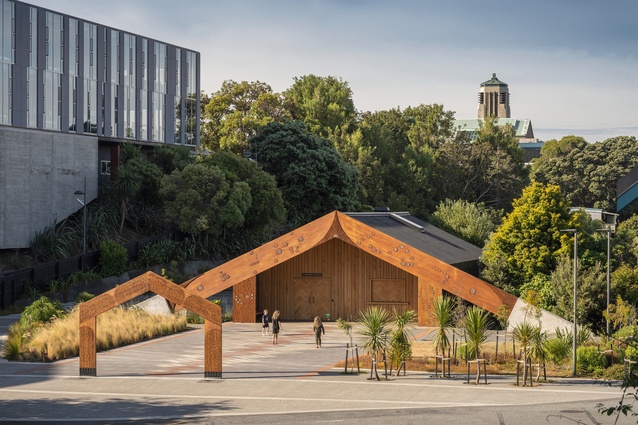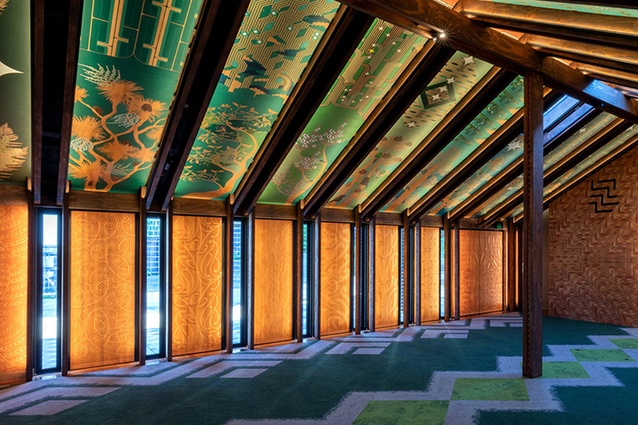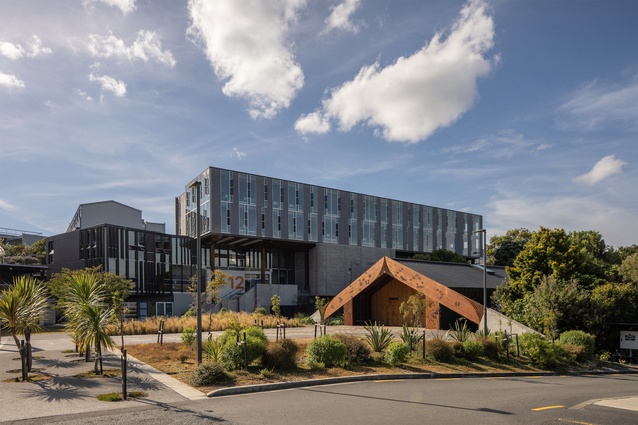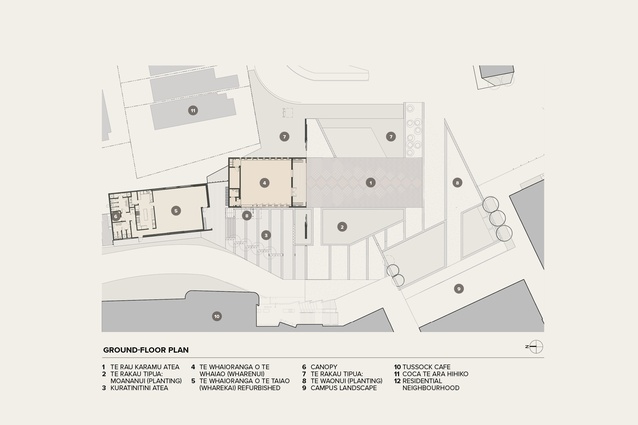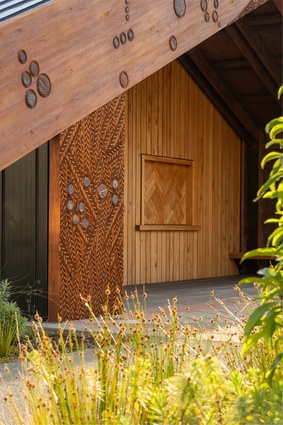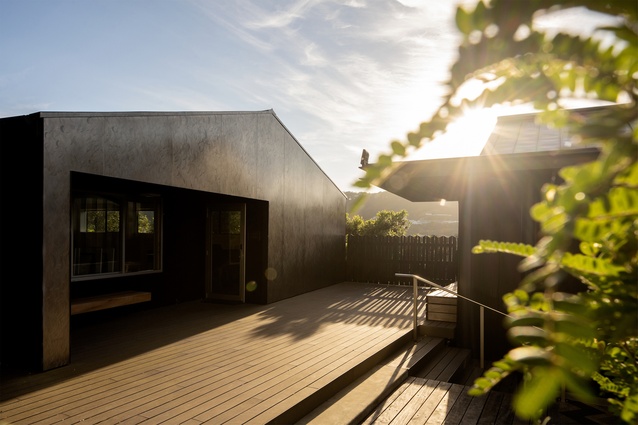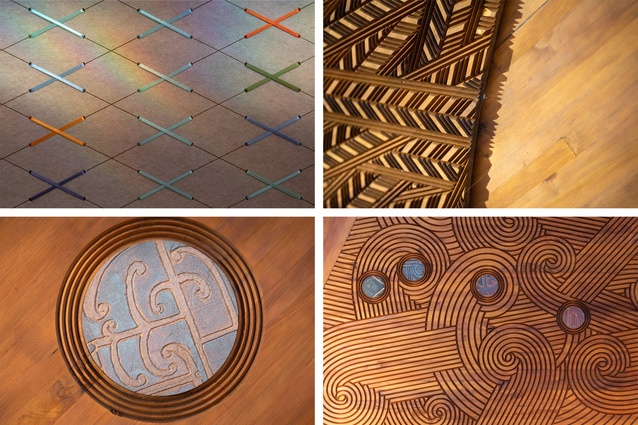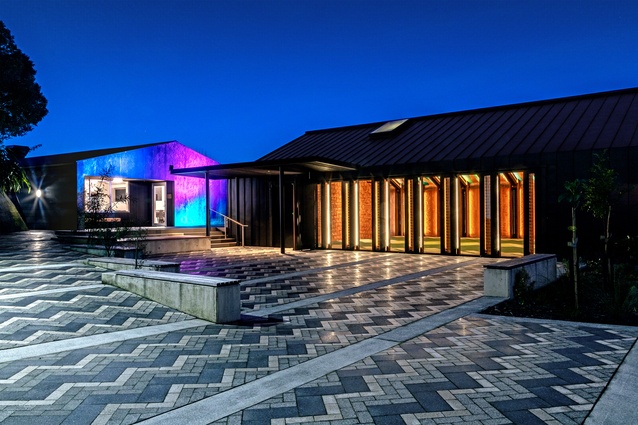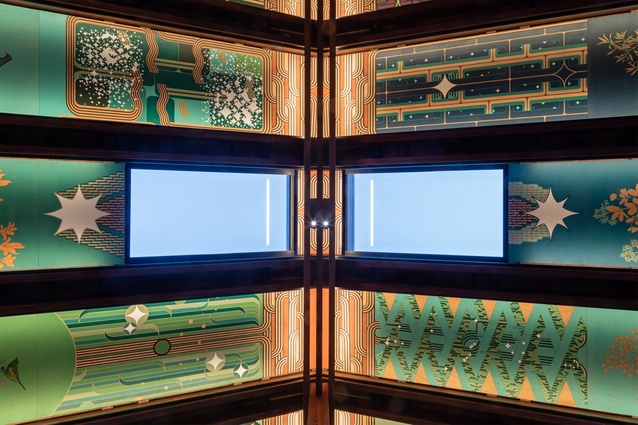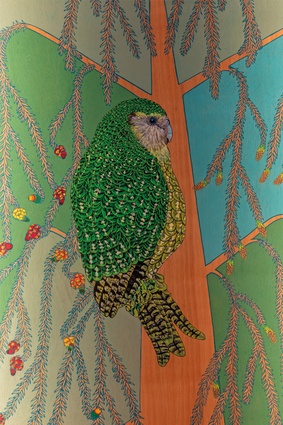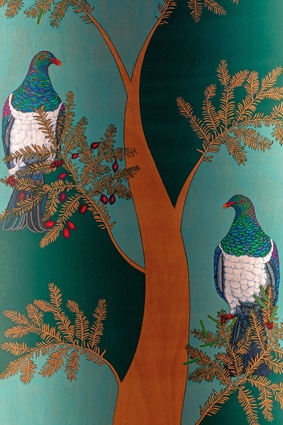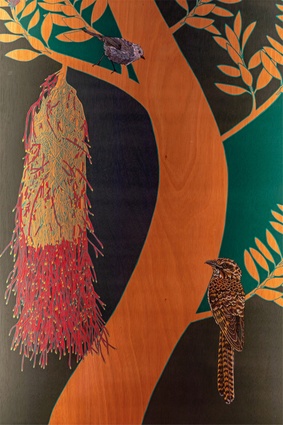Deeply inherent and indivisible
Hugh Tennent visits Massey University Wellington's new marae, Te Rau Karamu, and finds a unique collaboration between Te Kāhui Toi and Athfield Architects.
The newly completed marae for the Massey University Wellington Pukeahu campus is the latest expression of contemporary marae serving public and tertiary institutions in Aotearoa. Opened in 2021, Te Rau Karamu punches above its weight, with its deft spatial reordering of the main public courtyard of the campus combined with extraordinary contemporary whakairo forming a te ao Māori expression of power and beauty.
Designed by Athfield Architects and the collective of contemporary Māori artists and makers Te Kāhui Toi, the project took many years to realise: time which is evidenced in the depth of an outcome which is both simple and richly layered. It is the dual contribution of form and whakairo, the architects (and their early advisors) and the artist-designers (supported by tohunga and tribal leaders) that have achieved a “resolved complex that reflects the highest values of mana and manaakitanga”.1
At a glance across the courtyard or from surrounding buildings, the arrangement is familiar and almost diagrammatic: a starkly portalled timber tomokanga (gateway) threshold to an extended ātea, afront a wharenui with massively scaled maihi (bargeboards) and amo (columns). However, once I am standing at the gateway, the effect is far more immersive. The tomokanga is richly patterned with CNC-cut patterns, framing the entirely warm, broad timber presence of the mahau and wharenui. The ātea surface is strongly patterned, as are the large bargeboards and columns; all of these elements express kōrero of the kaupapa of the marae, and the indivisible connections of the past and future.

This is only a description of the āhuatanga, the form. As for the experience, at the gateway, the karanga begins: the compelling call and response summoning the movement towards meeting. The marae forms are all in service of the transforming ritual of pōwhiri and the being together that follows. As this marae operates with Te Āti Awa kawa, manuhiri are called into the house for hongi followed by whaikōrero. And what a house it is. But more on this later.
This marae, named Kuratini, was first established on Buckle Street in 1977 and moved to the Massey campus in 1990. As with Te Herenga Waka marae at Victoria University of Wellington, it was offered a narrow leftover pocket of campus to be established: tucked up against a bank, shaded and generally hidden. The light and presence for Kuratini Marae was to be further diminished with the long and high College of Creative Arts (CoCA) building. A cultural impact statement for the Pukeahu area by Morrie Love identified the historical significance of the area for Māori and the real need to uplift outcomes for the marae. Athfield Architects, in consultation with Professor Ross Hemera of CoCA, undertook early explorations focused on building a new wharenui on the site of the existing ‘relocatable’ wharekai/classroom, and repurposing the existing wharenui as wharekai.
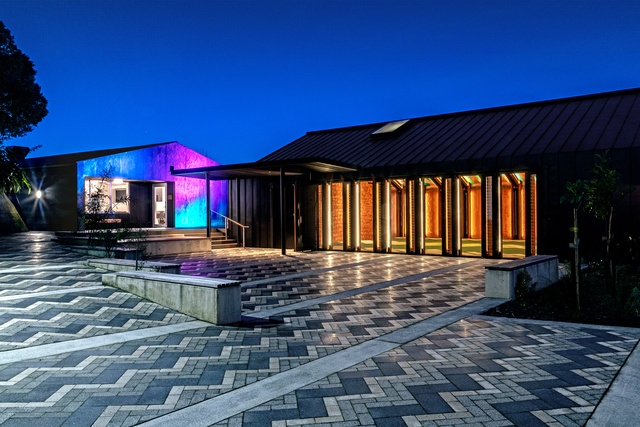
This simple strategy allowed a new wharenui and ātea to engage with the main outdoor space of the campus, thus increasing its presence from a previously hidden position. A side courtyard, aptly named Kuratinitini (learning place for the multitudes and honouring the original marae), allows for an increase of capacity on big occasions, with the innovative idea of opening the side of the wharenui. The space also serves to reveal and provide entry to Te Whaioranga o Te Taiao, the wharekai behind. This courtyard is a sheltered morning suntrap, well enjoyed by students.

The project, initially championed by Massey Deputy Vice-Chancellor Māori Selwyn Kātene, gathered momentum and saw the original marae close in 2015 for construction, with the newly designed marae built without whakairo, embodying the spatial arrangement developed since 2009. The wharekai and wharenui are small, modest metal-clad buildings. The architects devised the oversized extended maihi, connected to concrete anchor blocks for lateral bracing and to increase the presence of the building. This, along with the extended ground planes of the ātea and side space of Kuratinitini, achieves the enlargement needed to establish the marae firmly amongst the tall surrounding buildings.
Internally, the architects designed a skeletal LVL timber structure of paired posts and paired rafters, supported on a three-member tāhuhu (ridge beam), with a central pou tokomanawa, again of paired members. Unadorned, with a red-brown finish, this free-standing structure forms recesses for the whakairo panels. It reminds me of John Scott’s churches and the straightforward New Zealand stick building tradition. In this instance, the pairing creates a rhythm of positive and negative spaces, within which sit the illuminated whakairo panels, bookended by the beautiful front and rear walls.

The whakairo of the wharenui are quite simply stunning. Rich, detailed, exceedingly warm, diverse yet coherent, all the surfaces of the space are alive with pattern and movement, and all are beautiful. This quality uplifts the spirit, inviting engagement and reflection: the perfect vehicle for a central purpose of the marae, that of wānanga (learning environment).
Te Kāhui Toi formed after the decommissioning of the previous marae. Kura Puke, Associate Dean Māori at Massey CoCA, and Professor Ngatai Taepa combined a team of artists and designers, including previous collaborators Saffronn Te Ratana and Hemi Macgregor, and with Massey Spatial Designer Stuart Foster, Maihi Potaka, tikanga advisor Kurt Komene, ceramic artist Wi Taepa and many other contributors.

Ngatai, Kura and Stuart welcomed me onto the marae, supported by Ari Stevens, the dedicated project architect of Athfield Architects. From the outset, I came to appreciate what a privilege it was to be invited onto this marae, and to listen to the whakaaro (ideas/intention) underpinning its many elements.
At the tomokanga, the simple portal gateway comes alive with the kōrero of the whakairo. The kōwhaiwhai represent the young people coming to learn, with background carving of cicadas chirping and buzzing with energy, and, on either side, the footprints of the pūkeko and the moho (now extinct) point to a doorway of the past and future. At the top, Te Raukura, the three feathers symbol of Parihaka, of Te Whiti and Tohu, represent honour, peace and goodwill, and signal the kawa of the marae as Te Ātiawa.
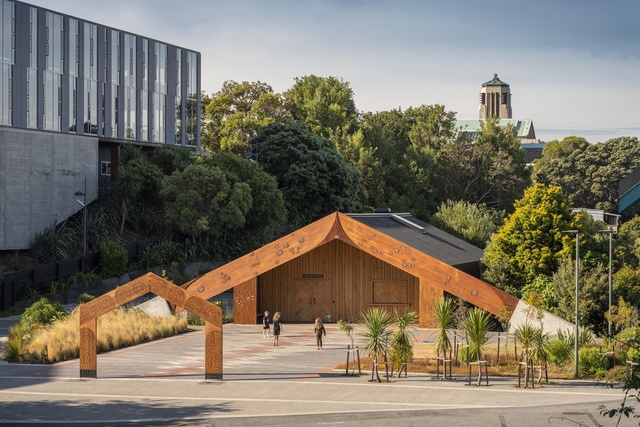
The ātea itself has a strongly patterned whāriki (mat) representative of the cosmos, and defines the sanctity of the space as a place of the passing of tīpuna. The original university concept was of a shared space with cars on a notional ātea to be emptied on occasions. Te Kāhui Toi persevered to create a Māori space of sanctity, by Māori and for everyone, without cars. The sanctity is further structured by bordering landscaped areas. Kura worked with landscape architects from Studio Pacific Architects and others in the selection of important rākau (trees) for the planting.
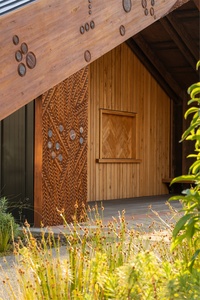
The massive maihi are from glue-laminated tōtara and have been visually lightened by curved areas of relief at the apex and anchor block connection. This gesture ameliorates the groundedness, making the static delicate. It speaks of the relationship between Papatūānuku and Ranginui. Adorning the maihi and amo are inlaid compositions of detailed clay works by Wi Taepa: star constellations that indicate the changing of seasons, a maramataka (calendar).
The design conception of this wharenui, Te Whaioranga o Te Whaiao, relates to a defined area within Te Wao Nui (the great forest), and focuses on the role of atua such as Tāne Whakapiripiri and Hinewaonui in the creation of Te Rākau Tipua (the cosmic tree). This orientation towards Te Taiao (the natural world) becomes entirely evident inside the whare. The rear wall of intricate stepped battens in relief represents the roots, the responsibility of Kura and Stuart. It provides a unified, almost-woven plane to anchor the space. Similarly, the inside of the front wall is equally distinctive and compelling. Designed to address and protect the atypical south orientation of the whare, it is created from digitally woven vertiface over cube acoustic panels. A swirling pale-blue, orange and white cloudscape sits above an area of diagonally aligned, coloured hand stitches, which appear almost as digital coding and were hand-stitched by the community.
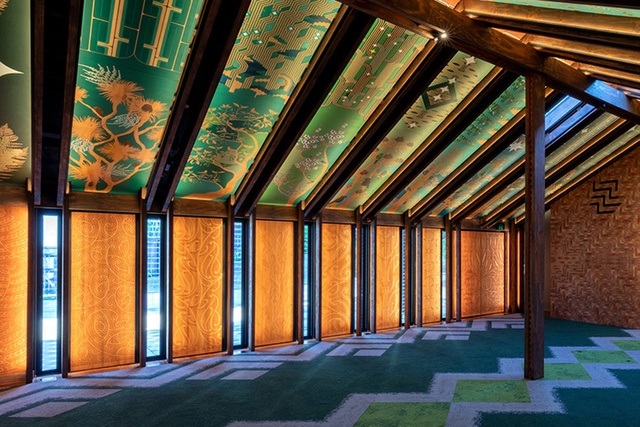
The pictorial ceiling panels, in predominantly cooler tones of greens and blues, depict the trunk and branches of the cosmic tree and are exquisite. Saffronn (Ngai Tūhoe) was responsible for the rākau and manu (trees in flower and birds) which adorn each panel; more than 16 differing depictions remind me of the finest Edo-period Japanese paintings. In the upper part of the panels is the equally exquisite celestial realm of stars amongst patterned motifs visible through the porous ridge beam, the responsibility of Hemi (Ngai Tūhoe). As with a traditional whare wānanga, the entire space can be blacked out and, as the lights are dimmed, the whetū (stars) are last to be seen. The wharenui is used for sleeping on noho marae and wānanga so imagine the enchantment of lying, looking up at the fading light of the forest and the stars remaining, hearing kōrero of the cosmic tree, the constellations, karakia and waiata. The ceiling is the fifth wall of the wharenui: an abundant expression of Te Taiao.

The side panels depict insects, leaves, micro-organisms, and mosses; there are panels of light, water and the moon, and corner panels of the seasons. The responsibility of Ngatai, these CNC-cut tōtara panels are coloured with a naturally pigmented oil, which is deeply warm, illuminated by the very clever use of hidden lighting. The panels, separated by narrow, ventilating windows, articulate and unify the sides of the space, connecting the branches above to the forest floor of the patterned carpet. They are elegant, vibrant and incisive yet soft. The western side panels can open on big occasions to Kuratinitini courtyard, which depicts Te Moanā-nui (the realm of the ocean), and thus create a threshold of the two realms, land and sea.
Te Whaioranga o Te Taiao, the wharekai, sits elevated and partially behind the wharenui and speaks of a defined zone in Te Moanā-nui. The facing façade is clad entirely with stainless-steel panel, patterned with a hand-held grinder. The effect is to dematerialise the flat metal to the quality of diaphanous wetness. It was conceived by artist Israel Birch as the skin of Tangaroa, composed of unaunahi (fish scales) and lit with changing coloured lighting potentially shifted by an algorithm timed with the tidal movements in the harbour. The effect is expansive and beguiling, evoking the ocean with paua-coloured hues, and of light emanating from below the surface. Internally, the wharekai is familiar and recognisable as a communal dining space, with aramoana patterned flooring, pale walls, Formica and stainless surfaces. However, three neon light works by Robert Jahnke are equally mysterious, with mirrored backing offering endless diamond forms recalling the customary pākati pattern. As with the wharenui, the wharekai is imbued with a conception evoked by exceptional toi.
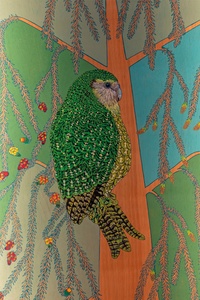
Half my lifetime ago, I participated in a silent meditation retreat, sequestered from the world for three months. During this period, the retreatants were given only two pieces of news from the outside world: the Berlin Wall had come down, and the Dalai Lama had received the Nobel Peace Prize. One of the teachers described giving the Dalai Lama the Nobel Peace Prize as like giving nature an art award. I’m reminded of this analogy when thinking about Te Rau Karamu. It talks of something deeply inherent and indivisible.
The humble buildings arranged in expansive sequence, the scaling and continuous application of extraordinary embedded whakairo, the inherent embrace and protection of the kawa and tikanga of Te Raukura: all are there to create an experience for those who enter which is encompassing and indivisible. Indivisible because the surfaces are not only beautiful but deep with mātauranga, and because the qualities described are the very nature of this marae.
I consider this to be a seminal work. The level of contemporary artistry founded on guidance from iwi and tohunga, and the creative collaboration, prolonged commitment and combined intent of Te Kāhui Toi and Athfield Architects have resulted in an indigenous space of exceptional quality.
Reference: 1 Te Kāhui Toi.

